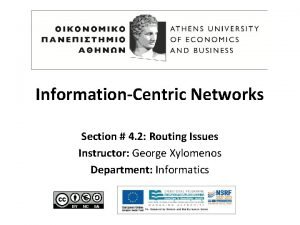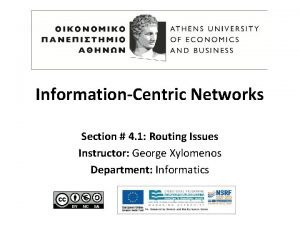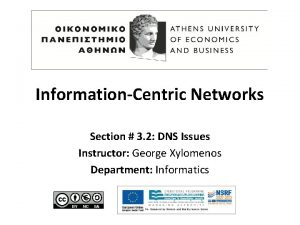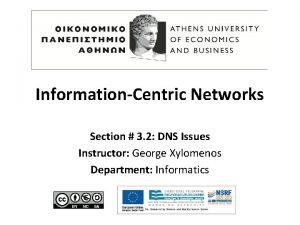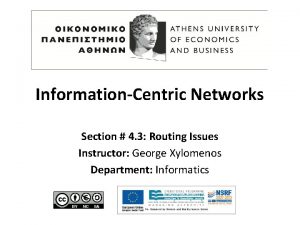InformationCentric Networks Section 13 2 Alternatives Instructor George













- Slides: 13

Information-Centric Networks Section # 13. 2: Alternatives Instructor: George Xylomenos Department: Informatics

Funding • These educational materials have been developed as part of the instructors educational tasks. • The “Athens University of Economics and Business Open Courses” project only funded the reformatting of these educational materials. • The project is being implemented as part of the Operational Program “Instruction and Lifelong Learning” and is cofinanced by the European Union (European Social Fund) and national funds.

Licencing • These educational materials are subject to a Creative Commons License.

Week 13 / Paper 1 • Open. Flow: enabling innovation in campus networks – Nick Mc. Keown, Tom Anderson, Hari Balakrishnan, Guru Parulkar, Larry Peterson, Jennifer Rexford, Scott Shenker, Jonathan Turner – ACM SIGCOMM CCR, Volume 38, Issue 2, April 2008 • Main point – Open. Flow is a way to experiment with Ethernet switches • Adds a flow table to switches • Uses a standardized interface to manipulate that table – Allows cross-platform experimentation – Does not compromise vendor’s intellectual property – Complements large-scale testbeds with switching intelligence Information-Centric Networks 13 b-4

Need for programmable networks • Networks have become to important to play with! – – Vendors do not want to build “incompatible” switches Operators do not want to experiment with production traffic No way to try out new ideas in a realistic setting Result: the infrastructure seems “ossified” • Programmable testbeds – – GENI in the US is a network built for experimentation Virtualized switches allow many experiments to run A very ambitious and costly plan that will take years to deploy Can we at least run experiments in a campus network? • Need to persuade operators that they will not create problems • Need to isolate experimental traffic • Need to provide the right (which? ) functionality Information-Centric Networks 13 b-5

Using Open. Flow • Assume that Amy invented Amy-OSPF to replace OSPF – Amy-OSPF runs in a controller connected to the switches – The traffic could start from a single machine • A wildcard action is used to capture packets from this machine • Each such packet is encapsulated and passed to the controller – Processing for each new flow • The controller creates a path through the switches • Flow table entries are inserted along the path • These entries are more specific than the generic one • Approach tested in the Ethane prototype – A PC could process over 10. 000 new flows per second – Dedicated hardware could do much better than that – A prototype controller called NOX is built as a follow-on Information-Centric Networks 13 b-6

The Open. Flow switch • Open. Flow-enabled switches – Normal switch with added Open. Flow capabilities • Flow table, protocol and secure channel • May reuse existing hardware for these – Must isolate production from experimental traffic – Two ways to isolate traffic • Use another action (forward packets normally) • Use VLANs to distinguish traffic • Additional features – Type 0 switches are as described above – Extra features are possible • Header rewriting or matching non IP headers – Could be standardized in a Type 1 switch specification Information-Centric Networks 13 b-7

Deploying Open. Flow switches • Open. Flow consortium maintains specifications – Licensing is free even for commercial use – Products need to conform to Type 0 specifications • Actual deployment – Many vendors are working on supporting Open. Flow – Stanford has deployed Open. Flow across some buildings • Different VLANs used to separate production traffic • Researchers can control their own traffic • Reference platforms – Type 0 reference designs are available – Linux, Net. FPGA and Open. WRT Information-Centric Networks 13 b-8

Using Open. Flow • Example 1: network management – The first packet of a flow triggers flow admission • Example 2: VLANs – Packets are tagged with a VLAN id depending on flow entry • Example 3: mobile wireless Vo. IP – The controller tracks clients and re-routes connections • Example 4: non-IP networking – Identification via MAC type or IP version number – Ideally should use generic header matching • Example 5: per packet processing – Process all packets at the controller – Divert packets to a Net. FPGA device Information-Centric Networks 13 b-9

Need for programmable networks • Option 1: persuade vendors to offer programmability – Each vendor has a different, closed platform – No motivation to open their platform to competition – No assurance that regular operation will be unaffected • Option 2: move to software platforms – Could be simple PCs with Linux, XORP, Click – Very low speed and port density compared to hardware • Option 3: move to programmable hardware – Platforms with network processors exist but are too expensive – Net. FPGA is cheap but too limited for production use • Option 4: Open. Flow – Allow vendors to open a useful but limited part of their platforms Information-Centric Networks 13 b-10

The Open. Flow switch • Most switches contain flow-tables – Used for firewalls, NAT, Qo. S, statistics – Different per vendor but with a common set of functions – Open. Flow allows programming this common set • Open. Flow switches – A flow table with an action per entry • At least a minimum set of actions must be supported – A secure channel to a controller to program the table – A protocol allowing the controller to talk to the switch • The only standardized part – Switches can be dedicated or just compatible with Open. Flow Information-Centric Networks 13 b-11

The Open. Flow switch • Dedicated Open. Flow switches – Simply follows actions from the flow table – A flow can be anything expressible in the protocol • Type 0 switches must understand 10 header fields • Port, VLAN, Ethernet SA/DA/Type, IP SA/DA/Protocol, TCP SP/DP – A basic set of actions • Forward packets to a port or ports • Encapsulate and forward packets to controller • Drop flow packets – Flows can be added dynamically by looking at their first packet – Flow table entries • Packet header describing the flow • Action to take on matching packets • Statistics counters Information-Centric Networks 13 b-12

End of Section # 13. 2 Course: Information-Centric Networks, Section # 13. 2: Alternatives Instructor: George Xylomenos, Department: Informatics
 Alternatives to convolutional neural networks
Alternatives to convolutional neural networks Comparison of virtual circuit and datagram networks
Comparison of virtual circuit and datagram networks Backbone networks in computer networks
Backbone networks in computer networks George washington vs king george iii venn diagram
George washington vs king george iii venn diagram Venn diagram ghent
Venn diagram ghent Tipos de participantes en un curso
Tipos de participantes en un curso Basic instructor course texas
Basic instructor course texas Basic instructor course texas
Basic instructor course texas Basic instructor course #1014
Basic instructor course #1014 Pepperball instructor course
Pepperball instructor course Neither of my two suitcases are adequate for this trip
Neither of my two suitcases are adequate for this trip Instructor vs teacher
Instructor vs teacher Ospfv
Ospfv Mptc firearms instructor manual
Mptc firearms instructor manual
















